|
Advertisement / Annons: |
Globular Cluster |
| Object : | M3, Globular Cluster |
| Coordinates/Direction : | RA: 13h42m, DEC: +28o22' |
| Object size : | 18' |
| Object magnitude : | 6.2 |
| More to know : |
Wikipedia: https://en.wikipedia.org/ wiki/ Messier 3 |
M3, 2023-03-15: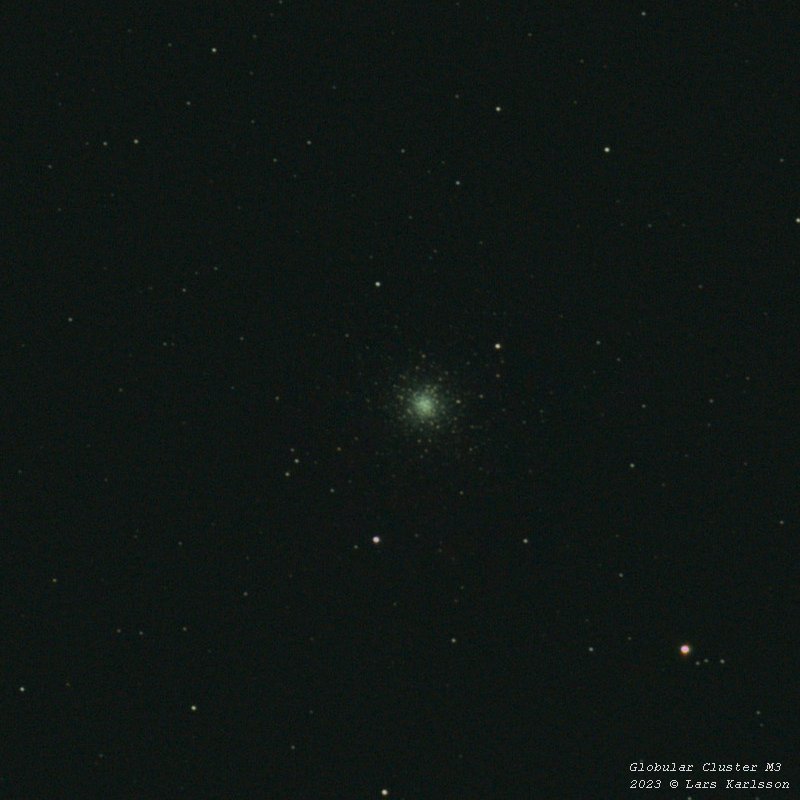 (Click on image and get one in full resolution in a new window)
(Click on image and get one in full resolution in a new window)
|
| Date : | 2023-03-15 |
| Time (UT) : | 19:06 to 19:25 |
| Mount : | SkyWatcher EQ6 Pro, Belt drive, beltdrive modified (DIY 2019) |
| Guide : | QHY5 camera with 200 mm f/3.5 lens |
| Lens/telescope : | Pentax 645 300 mm ED f/4 (medium format lens) |
| Corrector/Barlow : | - |
| Field (FOV) : | 6.8x4.5o (full frame) before crop |
| camera : | Canon 6D, QE=0.5, full frame, 20 Mpixel, 14 bit |
| camera temperature: | About 6o C above surrounding temperature |
| Film/CCD : | Raw, Cr2 |
| Filter : | none |
| Control system: | Mount, camera, focus, guide (Ekos) controlled by Astroberry (KStars/Ekos Linux) |
| Exp. time : | 24x30 seconds, iso1600, dithering mode |
| Image process tool : | Siril, Gimp, Irfanview |
| Processing : | flat calibration, no darks used, synthetic bias, photometric color calibration |
| Weather : | clear sky, temperature 0 C |
| Site : | Sweden, Stockholm, Hagsätra.
Bortle 9 Free view Az: 20o to 90o, 165o to 185o, Alt: 20o to 55o |
| Comment : |
In March from our balcony there are no exiting objects visible.
This time I took a new photo of the globular cluster M3 but now with the short 300 mm focal lens.
Even if M3 is a big globular cluster it need much more magnification which this setup can't deliver. I used a different method when calibrating the image. Normally I use darks which is subtracted. But modern cameras has very low static pattern and sometimes this can be replaced by a synthetic bias. The remaining static pattern is reduced by the dithering technique used when photographing. It makes everything much easier because the darks is very time consuming to maintain. And the random noise will also be lower with this, the bias is just a constant. Long time ago I always used this synthetic bias when calibrating. Hot pixels can be a problem to cancel out. |
M3, 2020-03-09, new processed: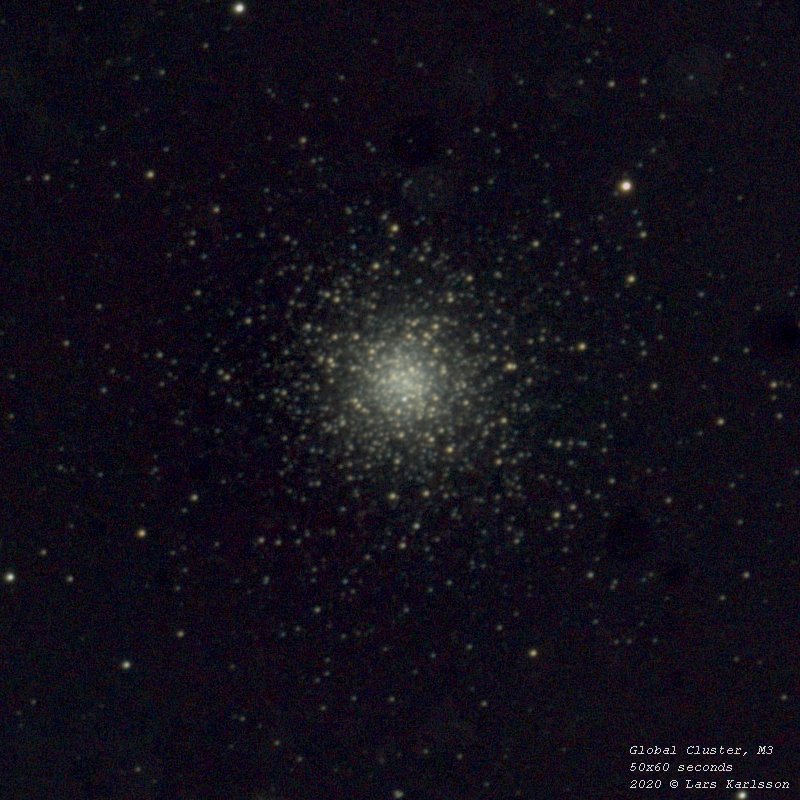 (Click on image and get one in full resolution in a new window)
(Click on image and get one in full resolution in a new window)
|
| Date : | 2020-01-09 |
| Time (UT) : | 00:40 to 01:51 |
| Mount : | SkyWatcher EQ6 Pro, Belt drive, beltdrive modified (DIY 2019) |
| Lens/telescope : | TS130 APO f/7 910mm, 3" focuser |
| Corrector/Barlow : | 3" field flatter, x1. T48 connector to camera |
| Field (FOV) : | 2.25 x 1.5o (full frame) before crop |
| camera : | Canon 6D, QE=0.5, full frame, 20 Mpixel, 14 bit |
| camera temperature: | About 6o C above surrounding temperature |
| Film/CCD : | Raw, Cr2 |
| Filter : | none |
| Control system : | Mount by EQMOD, camera by APT, guide by PHD2, focuser by USB-focus, ASCOM Windows PC |
| Exp. time : | 50x60 seconds, iso1600, dithering mode |
| Image process tool : | Siril, Gimp, Irfanview |
| Processing : | Synthetic bias, flat, phoketric color calibration |
| Weather : | clear short moment and clouds, temperature +3o C |
| Site : | Sweden, Stockholm, Hagsätra.
Bortle 9 Free view Az: 20o to 90o, 165o to 185o, Alt: 20o to 55o |
| Comment : | Going through old data. This one was almost trashed because of all dirt on the sensor, dirty image, many of them are drying stains. But with Siril and especially Gimp even all these dirt and stains can be handled. As usually there are a lot of back grounds objects: M3 plate solved. It has of course been better to take a new photo with a clean sensor. But good to practice on this, if it has been a comet, it can take thousand of years until it's back. If I compare with the one I took 2016 it isn't as sharp as that one. But it could be that I applied some kind of filter on it. |
M3, 2019-03-10, new setup: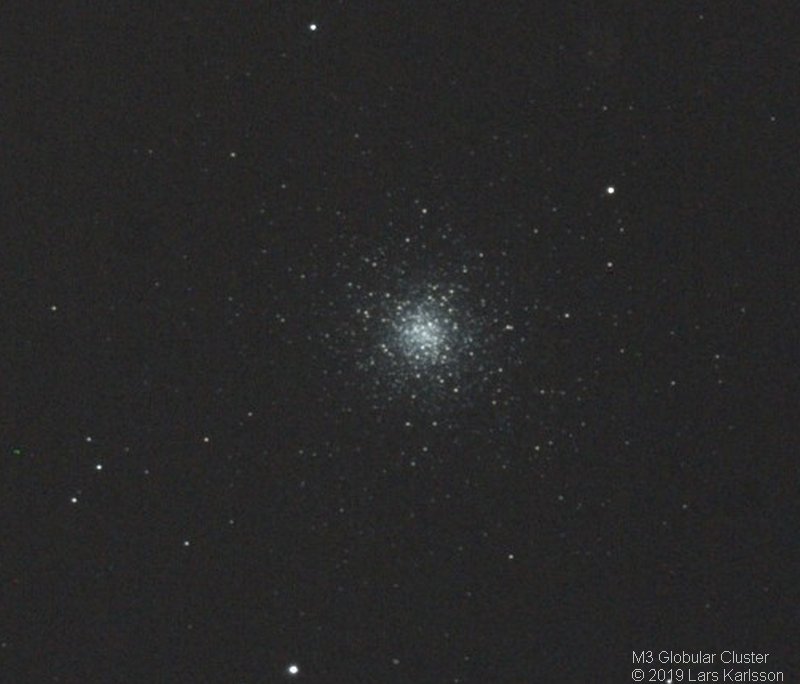
|
| Date : | 2019-03-10 |
| Time (UT) : | 21:32 to 21:58 |
| Mount : | SkyWatcher EQ6 Pro, Belt drive, beltdrive modified (DIY 2019) |
| Lens/telescope : | TS130 APO f/7 910mm, 3" focuser |
| Corrector/Barlow : | 3" field flatter, x1. T48 connector to camera |
| Field (FOV) : | 2.25 x 1.5o (full frame) before crop |
| camera : | Canon 6D, QE=0.5, full frame, 20 Mpixel, 14 bit |
| camera temperature: | About 6o C above surrounding temperature |
| Film/CCD : | Raw, Cr2 |
| Filter : | none |
| Control system : | Mount by EQMOD, camera by APT, guide by PHD2, focuser by USB-focus, ASCOM Windows PC |
| Exp. time : | 6x60 seconds, iso800, only 6 images used of 30, dithering mode |
| Image process tool : | AstroImageJ, Fitswork, Irfanview |
| Processing : | crop, level, flat calibration ,no dark&bias calibration |
| Weather : | clear short moment and clouds |
| Site : | Sweden, Stockholm, Hagsätra.
Bortle 9 Free view Az: 20o to 90o, 165o to 185o, Alt: 20o to 55o |
| Comment : |
It was more then three years ago I took any photo of the globular cluster M3.
When I started it looked good but then as usual the clouds come in and destroyed my night. Anyway I kept a few of the photos to have to compare with the old setup. I want to see if my new setup with longer focal length do any difference. And yes it do, but hard to compare a 6 minute exposure with 56 minutes. |
M3 2016-02-29: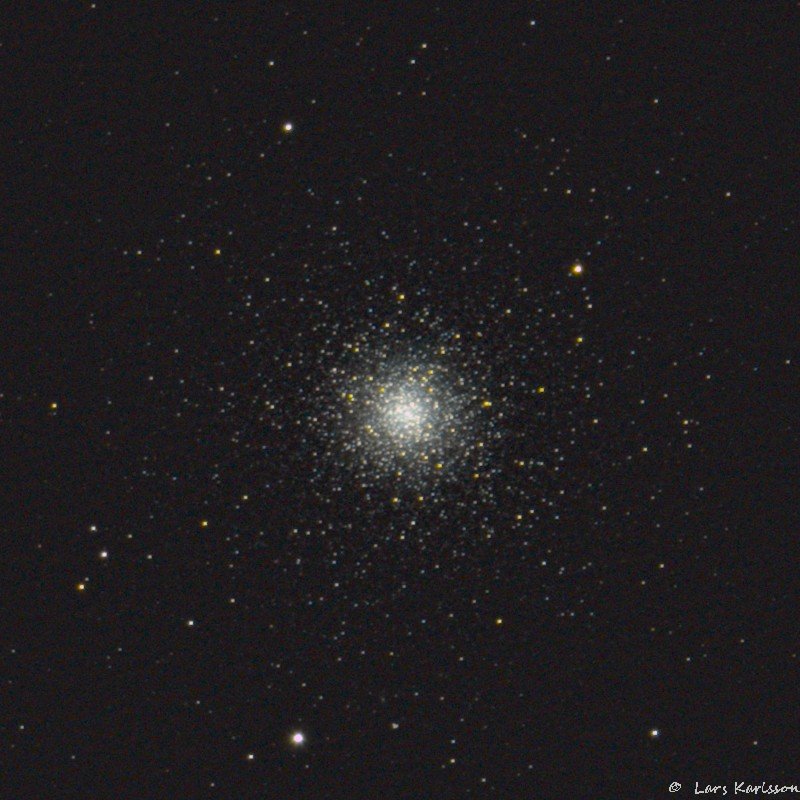
|
| Date : | 2016-02-29 |
| Time (UT) : | 22:53 to 23:57 |
| Mount : | SkyWatcher EQ6 Pro, Belt drive, beltdrive modified (DIY 2019) |
| Guide : | QHY5 camera with off-axis |
| Lens/telescope : | TS130 APO f/7 910mm (682mm, f/5.2), 3" focuser |
| Corrector/Barlow : | Riccardi 2.5" field flatter, x0.75. T48 connector to camera |
| Field (FOV) : | 3.0 x 2.0o (full frame) before crop |
| camera : | Canon 6D, QE=0.5, full frame, 20 Mpixel, 14 bit |
| camera temperature: | About 6o C above surrounding temperature |
| Film/CCD : | Raw, Cr2 |
| Filter : | none |
| Control system : | Mount by EQMOD, camera by APT, guide by PHD2, focuser by USB-focus, ASCOM Windows PC |
| Exp. time : | 28x120 seconds, iso800, dithering mode |
| Image process tool : | Fitswork, Irfanview |
| Processing : | crop, level, no cal dark&bias |
| Weather : | clear |
| Site : | Sweden, Stockholm, Hagsätra.
Bortle 9 Free view Az: 20o to 90o, 165o to 185o, Alt: 20o to 55o |
| Comment : |
A new attempt to catch the M3 globular cluster.
This time wasn't there any moon and a bit darker than normal.
I could use 120 seconds exposures which isn't very common from my place.
This time I also increased the dithering distance, now it was possible to completely eliminate the hot pixel without dark calibration frames. If the photo is studied in detail it's possibly to see that it's under sampled, a camera with smaller pixels had been an advantage in this case. |
M3 2016-02-17: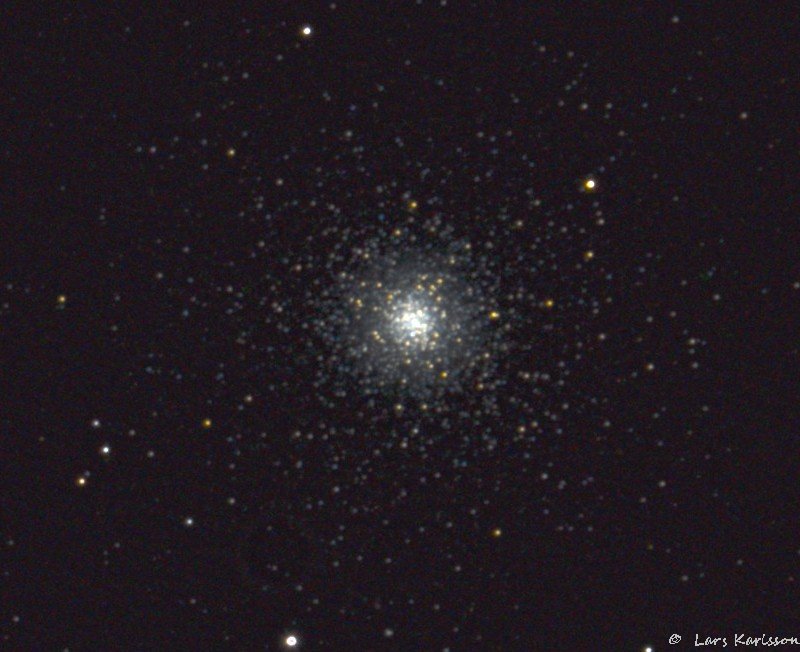 (Click on image and get one in full resolution in a new window)
(Click on image and get one in full resolution in a new window)
|
| Date : | 2016-02-17 |
| Time (UT) : | 22:59 to 00:23 |
| Mount : | SkyWatcher EQ6 Pro, Belt drive, beltdrive modified (DIY 2019) |
| Guide : | QHY5 camera with off-axis |
| Lens/telescope : | TS130 APO f/7 910mm (682mm, f/5.2), 3" focuser |
| Corrector/Barlow : | Riccardi 2.5" field flatter, x0.75. T48 connector to camera |
| Field (FOV) : | 3.0 x 2.0o (full frame) before crop |
| camera : | Canon 6D, QE=0.5, full frame, 20 Mpixel, 14 bit |
| camera temperature: | About 6o C above surrounding temperature |
| Film/CCD : | Raw, Cr2 |
| Filter : | none |
| Control system : | Mount by EQMOD, camera by APT, guide by PHD2, focuser by USB-focus, ASCOM Windows PC |
| Exp. time : | 60x60 seconds, iso800, dithering mode |
| Image process tool : | Fitswork, Irfanview |
| Processing : | resize, level, cal dark&bias flat |
| Weather : | clear, moon |
| Site : | Sweden, Stockholm, Hagsätra.
Bortle 9 Free view Az: 20o to 90o, 165o to 185o, Alt: 20o to 55o |
| Comment : | My astrosystem setup works better and better. This photo is taken with the temperature focus compensation activated. The telescope is very sensitive on focus, just a few degrees change in temperature get it off the perfect focus point. One degree Celsius change correspond to 95 step on focus motor. The AstroTortilla plate solve software that center the object in the frame let me work much faster, get me more time to sub exposures. The Canon 6D camera has much lower fixed pattern noise and the next thing to do is to work out a procedure that will not require dark calibrations in future. Dithering is one of these tools. Without the dark calibration the random noise will be a bit lower and save me a lot of work and hard disk space. |
My first photo of Messier 3, 2015-03-11: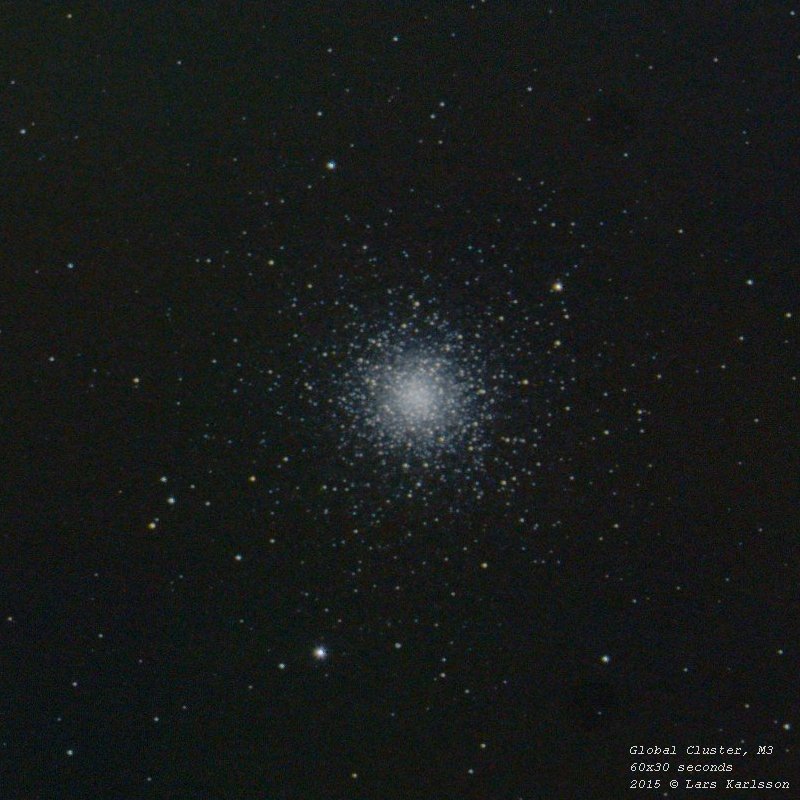 (Click on image and get one in full resolution in a new window)
(Click on image and get one in full resolution in a new window)
|
| Date : | 2015-03-11 |
| Time (UT) : | 21:14 to 22:23 |
| Mount : | SkyWatcher EQ6 Pro, Belt drive, beltdrive modified (DIY 2019) |
| Guide : | QHY5 camera with off-axis |
| Lens/telescope : | TS130 APO f/7 910mm (682mm, f/5.2), 3" focuser |
| Corrector/Barlow : | Riccardi 2.5" field flatter, x0.75. T48 connector to camera |
| Field (FOV) : | 3.0 x 2.0o (full frame) before crop |
| camera : | Canon 6D, QE=0.5, full frame, 20 Mpixel, 14 bit |
| camera temperature: | About 6o C above surrounding temperature |
| Film/CCD : | Raw, Cr2 |
| Filter : | none |
| Control system : | Mount by EQMOD, camera by APT, guide by PHD2, focuser by USB-focus, ASCOM Windows PC |
| Exp. time : | 60x30 seconds, iso800, dithering mode |
| Image process tool : | Fitswork, Irfanview |
| Processing : | resize, level, cal dark&bias flat |
| Weather : | almost clear, temperature -4o C |
| Site : | Sweden, Stockholm, Hagsätra.
Bortle 9 Free view Az: 20o to 90o, 165o to 185o, Alt: 20o to 55o |
| Comment : | One of the first photos with my new TS refractor. |
|
| Go Back |